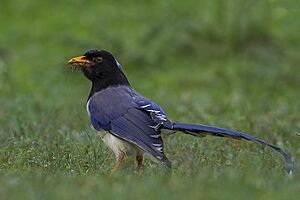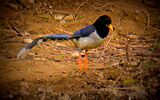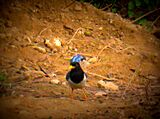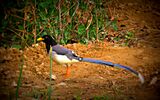Yellow-billed blue magpie facts for kids
Quick facts for kids Yellow-billed blue magpie |
|
|---|---|
 |
|
| From Chopta, Uttarakhand, India | |
| Conservation status | |
| Scientific classification | |
| Genus: |
Urocissa
|
| Species: |
flavirostris
|
The yellow-billed blue magpie, also known as the gold-billed magpie (its scientific name is Urocissa flavirostris), is a beautiful bird. It belongs to the passerine group, which means it's a perching bird. This bird is part of the Corvidae family, just like crows and jays.
The yellow-billed blue magpie is closely related to the Taiwan blue magpie and the red-billed blue magpie. You can find these birds in the northern parts of the Indian Subcontinent. They live in the lower Himalayan foothills. There's also a separate group of them living in Vietnam.
Contents
What Does the Yellow-Billed Blue Magpie Look Like?
This magpie is about 66 centimeters (about 26 inches) long. A big part of its length comes from its tail, which is around 46 centimeters (about 18 inches) long! Both male and female birds look very similar.
Their head, neck, and chest are black. They have a white patch on the back of their neck. The rest of their lower body is white, with a slight purple tint. Their upper body is a pretty purplish-blue color. This blue is even brighter on their wings and tail.
The tips of their flight-feathers are white. The outermost wing feathers are also white. Their tail is long and has feathers that get shorter towards the sides. The blue tail feathers have white tips. However, the two very long central tail feathers have a black band before the white tip.
Where Do Yellow-Billed Blue Magpies Live?
You can find the yellow-billed blue magpie all across the Himalayas. Their range stretches from Hazara to the Brahmaputra River. These birds are divided into two main groups, called subspecies.
One common subspecies is U. f. cucullata. This group lives from the western edge of their range to western Nepal. They are often seen in many hill stations of the Western Himalayas. They usually breed in areas between 1,500 and 3,000 meters (about 4,900 to 9,800 feet) high.
The other subspecies lives from Eastern Nepal eastward. This group has a slightly darker purple tint on their underparts. They prefer slightly higher areas and are rarely found as low as 1,830 meters (about 6,000 feet). These magpies usually stay in the same area all year. But in winter, they often move to lower places where it's warmer.
From Simla eastward, you might also see the red-billed blue magpie (Urocissa erythroryncha). This bird is closely related to the yellow-billed species. It's very common around Mussoorie, Tehri-Garhwal, Kumaon, and in Nepal. You can easily tell it apart by its red beak. It also has a larger white patch on the back of its neck.
How Yellow-Billed Blue Magpies Behave
Blue magpies mostly live in trees. They are most common in thick jungle areas. However, you can also find them in farm fields and on bare mountain sides at higher elevations. They often come down to the ground to find food. When they hop on the ground, they hold their long tail high. This keeps it from touching the ground.
These birds usually live in groups of seven or eight. They are very protective of their territory. When they fly out in the open, their flight is slow and wavy. Their diet includes small mammals, and the eggs and young of other birds. They also eat insects, wild fruits, and berries. These birds are quite noisy and make many different sounds.
Nesting and Reproduction
Magpies build their nests in the forks of trees. They choose areas with lots of leaves to hide their nests. Their nests are large and made of sticks. They line the inside with soft grass and other plant fibers.
A female magpie usually lays three or four eggs. The color of the eggs can vary. They might be a pale, dull yellowish-stone color or a darker, reddish-stone color. Sometimes, they even have a faint greenish tint. The eggs have small spots, blotches, streaks, and patterns of different shades of brown, sienna, or purple. These markings often gather in a cap or band around the wider end of the egg.
Images for kids











